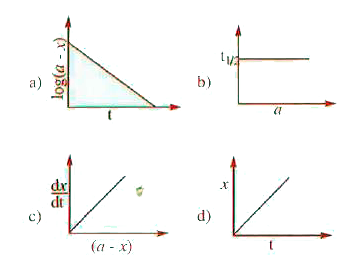In a zero order reactionn 47.5% of the reactant remains at the end of 2.5 hours. The amount of reactant consumed in one hour is Solution in Telugu
0.105
0.32
0.526
0.21
The correct Answer is:D
C0−Ct=K.t……………(1), x=K×1….2 52.5x=2.51⇒x=52.52.5=21
Topper's Solved these Questions
- BOOK - AAKASH SERIESCHAPTER - CHEMICAL KINETICSEXERCISE - PRACTICE SHEET-2 (LINKED COMPRHENSION TYPE QUESTIONS)6videos
CHEMICAL KINETICS
- BOOK - AAKASH SERIESCHAPTER - CHEMICAL KINETICSEXERCISE - PRACTICE SHEET-2 (MATCH THE FOLLOWING QUESTIONS)2videos
CHEMICAL KINETICS
- BOOK - AAKASH SERIESCHAPTER - CHEMICAL KINETICSEXERCISE - PRACTICE SHEET-1 (INTEGER ANSWER TYPE QUESTIONS)6videos
CHEMICAL KINETICS
- BOOK - AAKASH SERIESCHAPTER - CHEMICAL KINETCSEXERCISE - EXERCISE - 3.245videos
CHEMICAL KINETCS
- BOOK - AAKASH SERIESCHAPTER - CHEMICAL THERMODYNAMICSEXERCISE - Additional Practice Exercise54videos
CHEMICAL THERMODYNAMICS
Similar Questions
Elemantary unimolecular reactions have first order rate laws, elementary bimolecular reactions have second order rate laws. A rate law is often derived from a proposed mechanism by imposing the state approximation or by assuming that there is a pre -equilibrium. A proposed mechanism must be consistent with the experiment rate law.
The decomposition of O3 obeys the mechanism give below
Step 1: O3⇔O2+(O) (both forward and backward reactions are fast)
Step 2: O3+(O)slow−−→O2+O2 (ignore) backward reaction), the rate of reaction is given by03:48View SolutionMatch the following columns
 02:54View Solution
02:54View SolutionIn a gaseous phase reaction A2(g)→B(t)+1(1/2)C(g), the increase in pressure from 100 mm to 120 mm is noticed in 5 minute.The rate of disappearance of A2 in mm min−1 is
05:27View SolutionDiscuss on the kinetic spontaneity of a chemical reaction. Is a slow reaction spontaneous? Why?
05:20View SolutionWhich among the following is not an exact differential?
01:28View SolutionIn a first order reaction, the concentration of the reactants is reduced to 25% in one hour. The half-life periof of the reactions is
03:47View SolutionIn a zero-order reaction, if the initial concentration of the reactant is doubled, the time required for half the reactant to be consumed
02:08View SolutionIf one percent of the reactant decomposes in first minute in a first order reaction, calculate how much reactant would remain undecomposed after one hour.
05:59View SolutionSome graph are sketched for the reactant decomposes in one hour, 20% in two hours, 30% in three hours and so on. The dimensions of the rate constant is: The order of reaction are respectively.
07:00View SolutionFor a certain readction, 10% of the reactant decomposes in one hour, 20% in two hours and 30% in three hours. The unit of rate constant will be
03:11View SolutionHalf life of a first order reaction is 2 hours , what time is required for 90% of the reactant to be consumed ?
05:25View SolutionIn a first order reaction , the concentration of the reactant is reduced to 12.5% in one hour when was is reduced to 12.5 % in one hour . When was it half completed ?
03:35View SolutionThe half life period of a first order reactions is 10 mins. What percentage of the reactant will remain after one hour ?
02:44View SolutionIn a first order reaction , the amount of reactant decomposed in the first 1 min is 1 % of its initial amount. What percent of the reactant will remain undecomposed after 1 hour from the start of the reaction ?
05:00View Solutionएक प्रथम कोटि की अभिक्रिया की पांच अर्धआयु कालो के पश्चात अभिकारक की बची हुई भिन्न क्या होगी ?
02:40View SolutionWhich of the following graphs represent a first order reaction (a=initial concentration of reactant, x=concentration of reactant consumed, t=time)
 05:23View Solution
05:23View Solution

